This is a long post but after you are done reading it I think you will appreciate that it needed to be long. Just loading all these photos makes me tired but I tell you I will appreciate all of them in one place so as to refresh my memory. As much as I like to think I remember everything in the garden the reality is that I don't. So today we will talk about the Hydrangea paniculata (Panicled or Sun Hydrangeas) cultivars I grow in my garden. This is quite an interesting post to me because I get to really compare the eleven different cultivars I grow here in Tiger Way Gardens (the new gardens). Each hydrangea is unique but all have special attributes. Some were purchased because they were available to reasonably priced (Pink Diamond, Tardiva, Pinky Winky, Vanilla Strawberry, Limelight) while others were specifically sought out (Great Star, and Phantom). The others were just hydrangeas I happen to come upon at nurseries throughout my travels. Several were purchased in northern Illinois two years ago. These were not hydrangeas readily available to me in Tennessee (Great Star and White Diamond).

I grow eleven cultivars of the panicled hydrangeas. They are: 'White Diamond', 'Quick Fire', 'Pink Diamond', 'Tardiva', 'Pinky Winky', 'Vanilla Strawberry', 'Phantom', 'Limelight', 'Great Star', 'Bombshell', and 'PeeGee'. We will not be discussing the PeeGee Hydrangea today due to the fact it is not blooming. I will stick to the ten types. I grow all of these hydrangeas in very similar conditions. Seven of the cultivars are located in the above bed. The lace caps are sited at the top of the hill closest to the camera, while the full mophead type hydrangeas are further down the hill. I tried to space the hydrangeas according to ultimate size and bloom time. Most paniculata hydrangeas will easily grow to more than ten feet wide and tall but you can keep them smaller by pruning. I highly recommend you prune these hydrangeas because if you don't they will get leggy and stop blooming well for you. All of these hydrangeas bloom on new wood. My hydrangeas were all transplanted out to the new land in very late winter. I cut them all down to about two feet high. A couple of them ('Tardiva' and 'Pink Diamond') were extremely old hydrangeas (more than 10 years in my garden) so I was worried about moving them. They were also quite woody so once I cut them back severely there really was not too much left of the shrub. From the following pictures you will see they have recovered nicely. I will give you some tidbits on each of these hydrangeas as we go along and at the end I will tell you my favorite one. Remember, pretty is not always just in the looks-we also need substance.
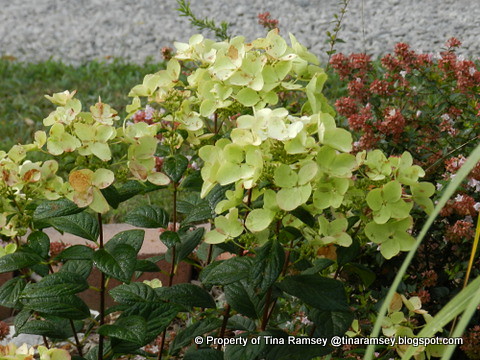
This beauty is 'White Diamond'. This is a smaller type panicled hydrangeas that is staying compact but ever so floriferous in my garden. It came into bloom more than a month ago when I posted on it in a prior post. As you can see the blooms have aged very well. Add to that fact that the leaves are very stout when compared to the other panicled hydrangeas in my garden and you have a complete winner. This is a hydrangea you can use in a foundation garden or anywhere for that matter. I highly recommend it.

Here is a long shot of the 'White Diamond'. It really is a nice plant without being too blowsy or to artificial. It really shines. I planted my two in a garden with abelias and plume grass.

'Quick Fire' is supposed to be an early blooming paniculata. That is why I planted it up close to the road. In my garden it is later than the other supposedly late hydrangeas. The bloom has not fully opened but it holds promise.
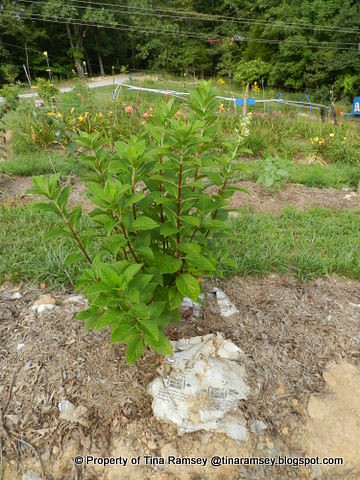
The stems are an attractive red and the shrub itself has a nice form-for now. This is a very young shrub. Hydrangea paniculatas will change depending on age and pruning habits of the gardener. This was a small shrub to begin with and I did not do too much pruning on it when I planted it out there.
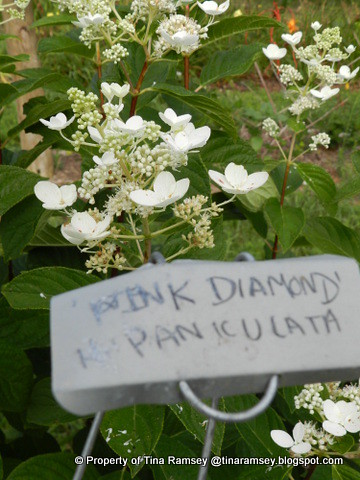
'Pink Diamond' is one of the oldest hydrangeas I have in my garden. I have had this in my garden for more than ten years. It was basically two or three woody stems that were so overgrown they were not productive anymore. Despite my trepidation about digging it up and moving it to the new gardens I plugged on and dug it up. I cut this whole shrub back severely. The branches you see came out of the root system or from the base of the woody trunks on this shrub. 'White Diamond' was always a favorite of mine and I am glad it has made the move well. It is a very drought tolerant hydrangea and blooms in part shade as well as sun. Look at all the blooms!
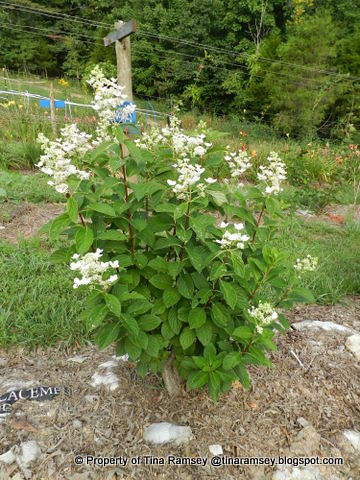
This is one of those paniculatas that will quickly get huge. You must keep up with pruning this one back. The way I prune mine is to cut it back to about 18-24" each year; usually in February before new growth begins. If you do not cut it back it will quickly become unproductive and too tall to even see the blooms. The stems will get quite woody and become unattractive.

This hydrangea is 'Tardiva' and it is a late hydrangea. It is the same age as 'Pink Diamond' and I did not think this one would come back either. This is another one of those hydrangeas I highly recommend you cut back. If you do not, take my word for it, it will quickly become leggy, unproductive and just plain ugly. Every few years I would recommend cutting it back very hard. I have found that after a few years of typical pruning the shrub winds up getting larger and larger and will have nubby trunks on it. Cutting it back almost to the ground will encourage new growth and lots of blooms. Since 'Tardiva' is a late hydrangea it is just now coming into bloom. Normally its bloom time is not until August.
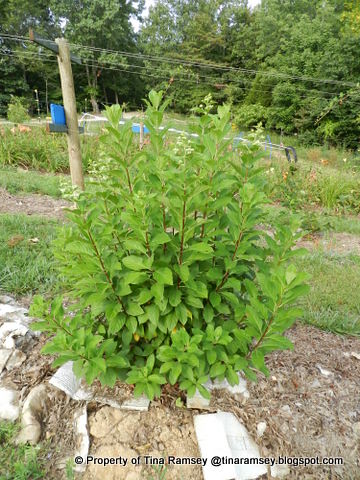
A long shot of the 'Tardiva'. You can see my cutting it back hard has really encouraged a lot of new growth. I like this rounded and bushy growth habit. If you grow panicled hydrangeas in the shade they will not be as bushy and blooming may suffer a bit. When grown in full sun the hydrangeas are quite bushy and full but you may need to water these hydrangeas during the summer. For the most part once these hydrangeas are established they are quite tough.
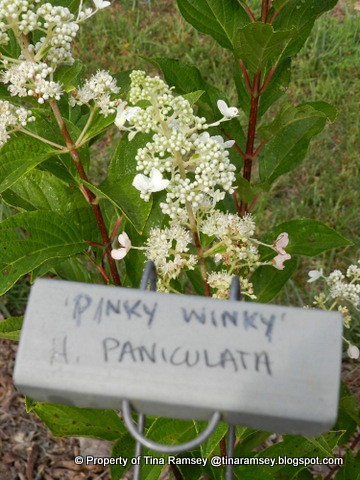
'Pinky Winky' looks suspiciously like 'Quick Fire'. I really can't tell the difference between them other than this one blooms a wee bit earlier than 'Quick Fire'. I am guessing it is called 'Pinky Winky' because as the blooms go by they get a bit of pink coloring as evidenced in the above photo.
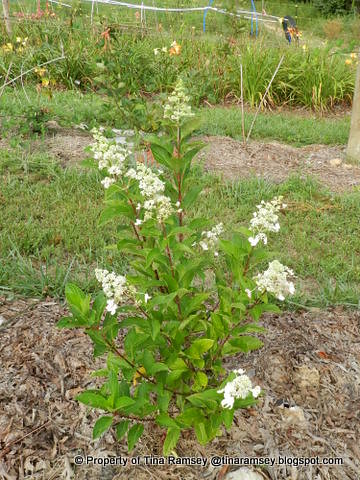
The stems are also red and the flowers are an attractive conical shape. This is a fairly new shrub to me so I will reserve judgement on it for a few years.
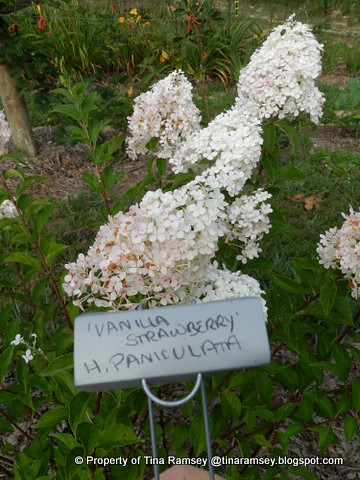
I am totally in love with the new to my garden 'Vanilla Strawberry' hydrangea. It has outshown even 'Limelight' and that is extremely hard to do in my opinion as 'Limelight' is the standard most panicled hydrangeas are judged by. These hydrangeas really make a nice show that can be seen several hundred feet away. I love that! As the blooms go by they are slowly turning an attractive pink; a stunning effect.
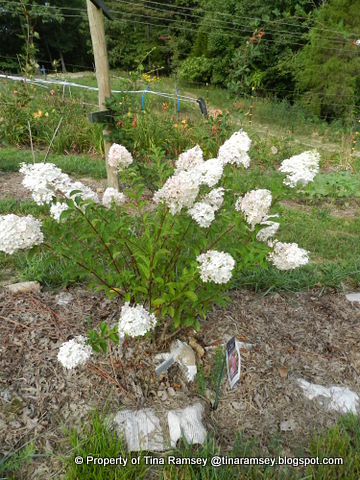
See what I mean by making a show? This is the first of the full headed panicled hydrangeas I will show you. There are two more plus PeeGee (but PeeGee is not covered in this post). I have found 'Vanilla Strawberry' needs more water than most of the other panicled hydrangeas I am profiling today. Hydrangeas will quickly tell you when they need a drink because they wilt. This means you might want to site it where you can easily provide it with a drink during the summer if it gets dry like it has been this summer.
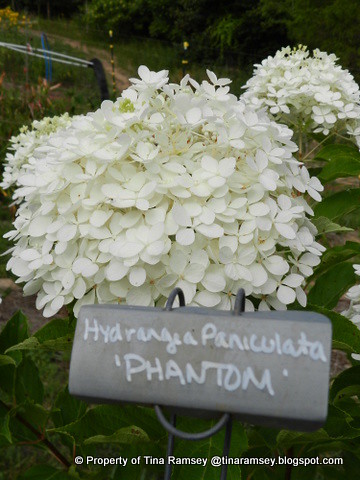
This one is 'Phantom'. 'Phantom' is one hydrangea I specifically bought for its traits. I ordered this beautiful shrub from a mail order firm that is no longer in business. When comparing which panicled hydrangeas I desired I had a choice between the 'Phantom' and 'Unique'. Now I don't grow 'Unique' so I cannot for sure say I chose the right hydrangea but at the time I read reviews on 'Phantom' that said this plant has some of the largest blooms available in the panicled hydrangea family. I have to agree. These flower heads are really large and round-they are not conical like most of the panicled hydrangeas. This hydrangea is very similar to 'Limelight' with the exception that the flowerheads are larger and are rounded. The whole shrub makes a nice show in the garden.

'Phantom' long shot showing the blooms and variation of growth.
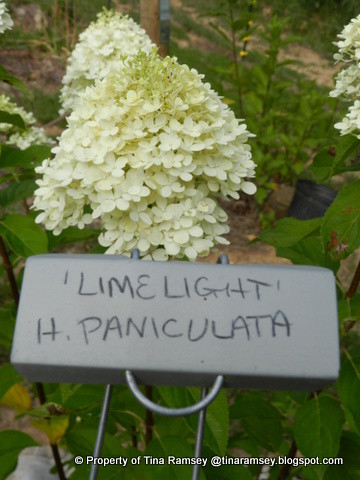
'Limelight' hydrangea is an awesome hydrangea. It has a very long season of interest that continues even after prime bloom time is over. These hydrangeas are lovely when picked and dried and brought inside for winter decorations. I can't get enough of my 'Limelight' hydrangeas. I have more than half a dozen more that will soon be making the long journey to the new garden where they will reside on the north side of a new large vegetable garden.
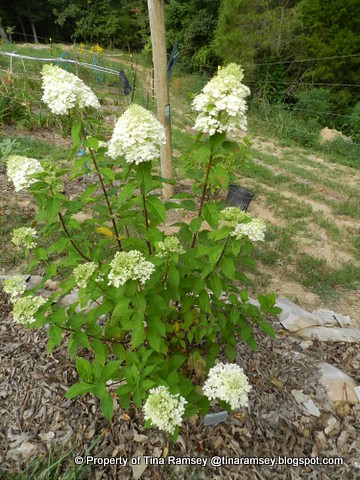
This shrub was quite small when I dug it up and moved it out here. I placed it at the bottom of the hill at the end of the bed because I know for a fact this shrub will easily grow to 10 feet quite quickly. While 'Limelight' needs to be pruned just like the other panicled hydrangeas 'Limelight' is easier to handle. There is really no wrong way to prune it. I have pruned it in the winter, in the spring, in the summer and in the fall. It will still bloom and still do well. If you prune it in the spring immediately stick the cuttings in the garden and keep moist. You will most likely be rewarded with a new plant in short order.
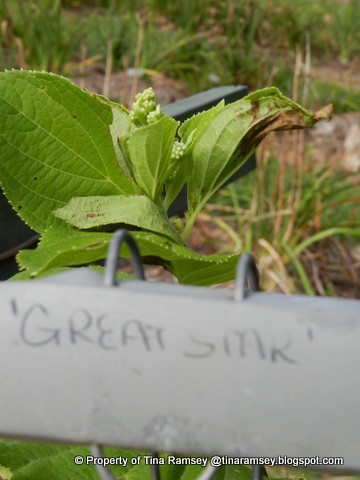
'Great Star' is a newer addition to my gardens. The two I have are placed at the end of beds on the lower side of the hill. They have really struggled with drought this year. I have had to water this hydrangea more than any other of the panicled hydrangeas. Despite this I believe this is a stellar hydrangea to grow. I don't have too many blooms on either one of my 'Great Stars' but I am hopeful that with time this hydrangea will settle in. I think out of the panicled hydrangeas I am profiling here this one would appreciate a little more shade than the rest.
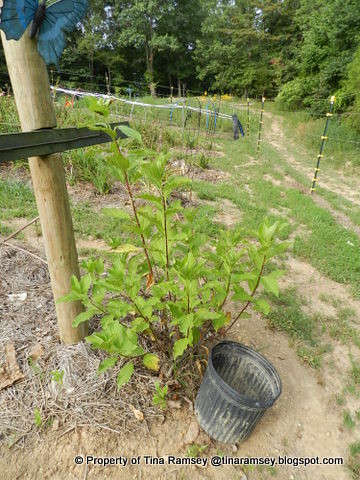
Both of my shrubs look like this. They were severely pruned back last fall when they were moved out here to the new gardens.
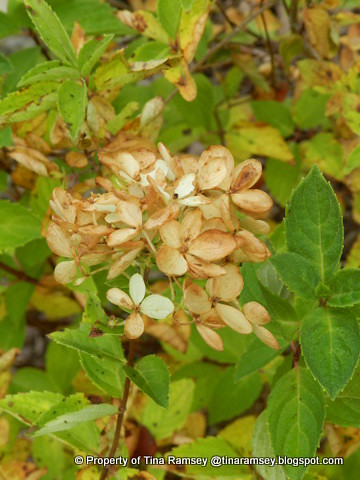
This last hydrangea is one I was most excited about when it first came out. I was excited because it seemed like it was the next 'hot' hydrangea that was going to be quite the thing in everyone's gardens. I must say it is quite a bomb in my garden and coincidentally, it's name is 'Bombshell' hydrangea. I was pretty excited to see it bloom-all two of them were kind of attractive though very small and not too bright. They turned a rusty brown color which while not unattractive, is not really all that attractive either. This is a picky hydrangea as far as growing conditions. It must have sun and will not do anything in the shade. It also needs a lot of water and is not the slightest bit drought tolerant as far as I can see.
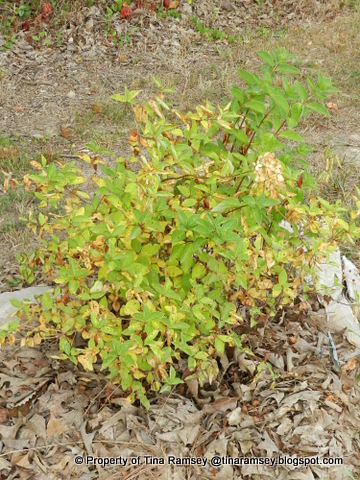
This one has been severely stressed by the drought here in my garden. You can see it quickly turned yellow and wilted. It is not wilted now because I have watered it. I planted this one with the mophead hydrangeas thinking it would be a good fit since it stays fairly small and the heads are round. I thought it would be tougher than the mopheads but in reality it is not. The only good thing I can say is it has not gotten leaf spot like the mopheads. I would not recommend this hydrangea to anyone. It is more like a dwarf version of the old standby PeeGee.
Okay, so which one of they hydangeas is my favorite? Gosh that is so hard because for me it depends on what is looking best at the moment. If I had to narrow it down it would have to be 'White Diamond'. This hydrangea can easily fit into all gardens, has a VERY long bloom time, and once the blooms turn they are still attractive, the leaves are very stout (I think this aids with drought tolerance and resistance to leaf spot), and this is just an all around great hydrangea that anyone can easily grow.
Which one do you like best and what experiences do you have with panicled hydrangeas....
in the garden....
Words and Photos Property of In the Garden Blog Team, In the Garden

I grow eleven cultivars of the panicled hydrangeas. They are: 'White Diamond', 'Quick Fire', 'Pink Diamond', 'Tardiva', 'Pinky Winky', 'Vanilla Strawberry', 'Phantom', 'Limelight', 'Great Star', 'Bombshell', and 'PeeGee'. We will not be discussing the PeeGee Hydrangea today due to the fact it is not blooming. I will stick to the ten types. I grow all of these hydrangeas in very similar conditions. Seven of the cultivars are located in the above bed. The lace caps are sited at the top of the hill closest to the camera, while the full mophead type hydrangeas are further down the hill. I tried to space the hydrangeas according to ultimate size and bloom time. Most paniculata hydrangeas will easily grow to more than ten feet wide and tall but you can keep them smaller by pruning. I highly recommend you prune these hydrangeas because if you don't they will get leggy and stop blooming well for you. All of these hydrangeas bloom on new wood. My hydrangeas were all transplanted out to the new land in very late winter. I cut them all down to about two feet high. A couple of them ('Tardiva' and 'Pink Diamond') were extremely old hydrangeas (more than 10 years in my garden) so I was worried about moving them. They were also quite woody so once I cut them back severely there really was not too much left of the shrub. From the following pictures you will see they have recovered nicely. I will give you some tidbits on each of these hydrangeas as we go along and at the end I will tell you my favorite one. Remember, pretty is not always just in the looks-we also need substance.

This beauty is 'White Diamond'. This is a smaller type panicled hydrangeas that is staying compact but ever so floriferous in my garden. It came into bloom more than a month ago when I posted on it in a prior post. As you can see the blooms have aged very well. Add to that fact that the leaves are very stout when compared to the other panicled hydrangeas in my garden and you have a complete winner. This is a hydrangea you can use in a foundation garden or anywhere for that matter. I highly recommend it.

Here is a long shot of the 'White Diamond'. It really is a nice plant without being too blowsy or to artificial. It really shines. I planted my two in a garden with abelias and plume grass.

'Quick Fire' is supposed to be an early blooming paniculata. That is why I planted it up close to the road. In my garden it is later than the other supposedly late hydrangeas. The bloom has not fully opened but it holds promise.

The stems are an attractive red and the shrub itself has a nice form-for now. This is a very young shrub. Hydrangea paniculatas will change depending on age and pruning habits of the gardener. This was a small shrub to begin with and I did not do too much pruning on it when I planted it out there.

'Pink Diamond' is one of the oldest hydrangeas I have in my garden. I have had this in my garden for more than ten years. It was basically two or three woody stems that were so overgrown they were not productive anymore. Despite my trepidation about digging it up and moving it to the new gardens I plugged on and dug it up. I cut this whole shrub back severely. The branches you see came out of the root system or from the base of the woody trunks on this shrub. 'White Diamond' was always a favorite of mine and I am glad it has made the move well. It is a very drought tolerant hydrangea and blooms in part shade as well as sun. Look at all the blooms!

This is one of those paniculatas that will quickly get huge. You must keep up with pruning this one back. The way I prune mine is to cut it back to about 18-24" each year; usually in February before new growth begins. If you do not cut it back it will quickly become unproductive and too tall to even see the blooms. The stems will get quite woody and become unattractive.

This hydrangea is 'Tardiva' and it is a late hydrangea. It is the same age as 'Pink Diamond' and I did not think this one would come back either. This is another one of those hydrangeas I highly recommend you cut back. If you do not, take my word for it, it will quickly become leggy, unproductive and just plain ugly. Every few years I would recommend cutting it back very hard. I have found that after a few years of typical pruning the shrub winds up getting larger and larger and will have nubby trunks on it. Cutting it back almost to the ground will encourage new growth and lots of blooms. Since 'Tardiva' is a late hydrangea it is just now coming into bloom. Normally its bloom time is not until August.

A long shot of the 'Tardiva'. You can see my cutting it back hard has really encouraged a lot of new growth. I like this rounded and bushy growth habit. If you grow panicled hydrangeas in the shade they will not be as bushy and blooming may suffer a bit. When grown in full sun the hydrangeas are quite bushy and full but you may need to water these hydrangeas during the summer. For the most part once these hydrangeas are established they are quite tough.

'Pinky Winky' looks suspiciously like 'Quick Fire'. I really can't tell the difference between them other than this one blooms a wee bit earlier than 'Quick Fire'. I am guessing it is called 'Pinky Winky' because as the blooms go by they get a bit of pink coloring as evidenced in the above photo.

The stems are also red and the flowers are an attractive conical shape. This is a fairly new shrub to me so I will reserve judgement on it for a few years.

I am totally in love with the new to my garden 'Vanilla Strawberry' hydrangea. It has outshown even 'Limelight' and that is extremely hard to do in my opinion as 'Limelight' is the standard most panicled hydrangeas are judged by. These hydrangeas really make a nice show that can be seen several hundred feet away. I love that! As the blooms go by they are slowly turning an attractive pink; a stunning effect.

See what I mean by making a show? This is the first of the full headed panicled hydrangeas I will show you. There are two more plus PeeGee (but PeeGee is not covered in this post). I have found 'Vanilla Strawberry' needs more water than most of the other panicled hydrangeas I am profiling today. Hydrangeas will quickly tell you when they need a drink because they wilt. This means you might want to site it where you can easily provide it with a drink during the summer if it gets dry like it has been this summer.

This one is 'Phantom'. 'Phantom' is one hydrangea I specifically bought for its traits. I ordered this beautiful shrub from a mail order firm that is no longer in business. When comparing which panicled hydrangeas I desired I had a choice between the 'Phantom' and 'Unique'. Now I don't grow 'Unique' so I cannot for sure say I chose the right hydrangea but at the time I read reviews on 'Phantom' that said this plant has some of the largest blooms available in the panicled hydrangea family. I have to agree. These flower heads are really large and round-they are not conical like most of the panicled hydrangeas. This hydrangea is very similar to 'Limelight' with the exception that the flowerheads are larger and are rounded. The whole shrub makes a nice show in the garden.

'Phantom' long shot showing the blooms and variation of growth.

'Limelight' hydrangea is an awesome hydrangea. It has a very long season of interest that continues even after prime bloom time is over. These hydrangeas are lovely when picked and dried and brought inside for winter decorations. I can't get enough of my 'Limelight' hydrangeas. I have more than half a dozen more that will soon be making the long journey to the new garden where they will reside on the north side of a new large vegetable garden.

This shrub was quite small when I dug it up and moved it out here. I placed it at the bottom of the hill at the end of the bed because I know for a fact this shrub will easily grow to 10 feet quite quickly. While 'Limelight' needs to be pruned just like the other panicled hydrangeas 'Limelight' is easier to handle. There is really no wrong way to prune it. I have pruned it in the winter, in the spring, in the summer and in the fall. It will still bloom and still do well. If you prune it in the spring immediately stick the cuttings in the garden and keep moist. You will most likely be rewarded with a new plant in short order.

'Great Star' is a newer addition to my gardens. The two I have are placed at the end of beds on the lower side of the hill. They have really struggled with drought this year. I have had to water this hydrangea more than any other of the panicled hydrangeas. Despite this I believe this is a stellar hydrangea to grow. I don't have too many blooms on either one of my 'Great Stars' but I am hopeful that with time this hydrangea will settle in. I think out of the panicled hydrangeas I am profiling here this one would appreciate a little more shade than the rest.

Both of my shrubs look like this. They were severely pruned back last fall when they were moved out here to the new gardens.

This last hydrangea is one I was most excited about when it first came out. I was excited because it seemed like it was the next 'hot' hydrangea that was going to be quite the thing in everyone's gardens. I must say it is quite a bomb in my garden and coincidentally, it's name is 'Bombshell' hydrangea. I was pretty excited to see it bloom-all two of them were kind of attractive though very small and not too bright. They turned a rusty brown color which while not unattractive, is not really all that attractive either. This is a picky hydrangea as far as growing conditions. It must have sun and will not do anything in the shade. It also needs a lot of water and is not the slightest bit drought tolerant as far as I can see.

This one has been severely stressed by the drought here in my garden. You can see it quickly turned yellow and wilted. It is not wilted now because I have watered it. I planted this one with the mophead hydrangeas thinking it would be a good fit since it stays fairly small and the heads are round. I thought it would be tougher than the mopheads but in reality it is not. The only good thing I can say is it has not gotten leaf spot like the mopheads. I would not recommend this hydrangea to anyone. It is more like a dwarf version of the old standby PeeGee.
Okay, so which one of they hydangeas is my favorite? Gosh that is so hard because for me it depends on what is looking best at the moment. If I had to narrow it down it would have to be 'White Diamond'. This hydrangea can easily fit into all gardens, has a VERY long bloom time, and once the blooms turn they are still attractive, the leaves are very stout (I think this aids with drought tolerance and resistance to leaf spot), and this is just an all around great hydrangea that anyone can easily grow.
Which one do you like best and what experiences do you have with panicled hydrangeas....
in the garden....
Interesting observations. I only have two of the ones you have written about. I agree with your findings on Vanilla Strawberry and Lime light. I am a whole zone colder than you too. I would love to see all of these hydrangeas when they get settled into your new garden.
ReplyDeleteAs you know, Hydrangea's are new to my Gardens. While some are doing well, even great, others become wilted during drought times. I must keep them happy with watering. I am thinking of moving them to another area as those seem to be the ones in the sandy soil. But for now, with our plentiful rainfalls this summer, I shall keep them in place... Maybe fall will see them moved. And maybe after your visit in Sept to McCorkles, you will have some new ones in your gardens as well...
ReplyDeleteThis was very informative and thank you for being so thorough. I lucked out in buying 4 'White Diamond' and 4 "Vanilla Strawberry' but not having done my homework as carefully as you. I have had both varieties for a couple of years now and they are glorious. Glad to read that they are earning a thumbs up from you. 'Bombshell' is a disappoint for me also esp. in comparison with the others.
ReplyDeleteI couldn't make a choice. I have one that has not bloomed. Maybe a move is in order.
ReplyDeleteOh my, I love all your hydrangeas, Tina! I only have a couple, but my favorite has to be 'Limelight.' Every year it just gets taller and taller and always rewards me with so many blooms, no matter what type of summer we have. I'm a timid pruner, so I've been pruning side branches every spring to train it into more of a tree shape, but I can see that I need to be braver in pruning it even more next year because it's getting too wide for its spot. 'Vanilla Strawberry' has really done well this year, too, though the branches are drooping--I wonder if all the blooms are weighting them down? Thanks for all the great tips on pruning, Tina; I'm always hesitant to cut too much back. And I'm going to look for 'White Diamond'--I have just the place for a smaller paniculata.
ReplyDeleteSo many beauties. I have one that seems to be growing only on top so I think it needs a better spot and to be pruned way back...you have given me the idea I really need to do this.
ReplyDelete